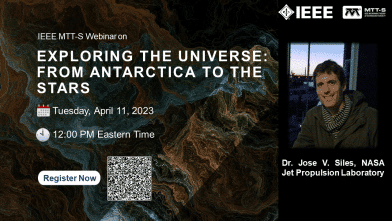
-
Tuesday, April 11, 2023 12:00 pm - 1:00 pm(New York Time) Add to my calendar
Exploring the Universe: From Antarctica to the Stars
Dr. Jose V. Siles
NASA Jet Propulsion Laboratory
Abstract: Have you ever wondered how our Solar System was formed? And the stars and planets of other solar systems? Galaxies are in fact live entities. Stars forms as a result of the gravitational collapse of the gas and dust in the interstellar medium, and then planets form around those stars. If any of those planets has the right size, is at the right distance and has the right constituents, life could emerge. But eventually, after several millions of years, the star will die, for instance as a massive explosion called supernova. All the material present in the system is then ejected back to the interstellar medium and the process stars again. Supernovas and massive stars redistribute the energy and mass in the interstellar medium regulating the rate at which new stars are formed. These mechanisms, called stellar feedback, play a major role in the evolution of galaxies and yet is not well understood. Thus, how galaxies evolve is still one of the open mysteries in Astrophysics.
Half of the luminosity of the Universe and 98% of all the photons emitted since the Big Bang belong to far infrared (terahertz) radiation. So, it is not surprising the most of the key tracers of star formation and life enabling molecules are in the far-infrared (e.g. ionized carbon, atomic oxygen, ionized nitrogen, water, etc.). Therefore, by studying star formation we are also contributing to answering questions such as “where are we coming from?”; “is there life elsewhere in the Universe.”
A simple scientific question like these often leads to a technology idea or concept that evolves until a mature cutting-edge scientific instrument is ready to explore the Universe and provide answers to these questions. One of the challenges in far infrared astronomy is that these emissions from stars are blocked by the water vapor of our atmosphere and are very difficult to be detected from the ground. As a cost-effective alternative to space, Antarctica represents one of the best places to look at the sky … but not from the ground. At NASA, “we are the explorers”, and this talk will try to justify this statement not only with words but also with some astonishing photos and videos of an actual exploration journey to Antarctica. The goal: to build and launch, from the bottom of the world, surrounded by ice and extreme cold, large far-infrared telescopes to study our Galaxy and other galaxies from the stratosphere.
Speaker’s Bio: Jose V. Siles (S’05–M’09-SM’16) received the Ph.D. degree in electrical engineering from the Technical University of Madrid, Madrid, Spain, in 2008. Part of this Ph.D. research was performed at the University of Rome “Tor Vergata”, Italy, and at the Observatory of Paris-LERMA, France. In 2008 and 2010, he was a Post-Doctoral Fellow with the Observatory of Paris-LERMA participating in several programs funded by the CNES, the European Space Agency and the European Commission. In September 2010, he joined the Submillimeter-Wave Advanced Technology Group at NASA’s Jet Propulsion Laboratory, California Institute of Technology, Pasadena CA, USA. His current research interests involve the design, development, and test of solid-state power-combined multiplied local oscillator sources and receivers for high-resolution multi-pixel heterodyne cameras at submillimeter-wave and terahertz frequencies for astrophysics, planetary science, and radar imaging applications. Dr. Siles was the recipient of a Fulbright Postdoctoral Research Award at NASA Jet Propulsion Laboratory for the period 2010–2012. He was also the recipient of the 2012 NASA/JPL Outstanding Postdoctoral Research Award and the 2019 NASA/JPL Lew Allen Award for Excellence. He has been part of two Antarctic campaigns (for a total of 5 months) supporting I&T and launch activities for the NASA Stratospheric Terahertz Observatory (successfully launched in 2016). He received in 2016 the U.S. Antarctic Service Medal. Currently, Dr. Siles is the Project Manager and Technical Lead of the NASA ASTHROS mission (a long duration stratospheric balloon-borne far-infrared radiotelescope planned to be launched form Antarctica in 2024), and also Instrument Systems Engineer of the radiometer instrument of the INCUS space mission. He is also an instrument rated airplane pilot and President of the Los Angeles Chapter of the Fulbright Association.